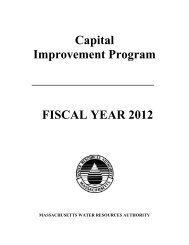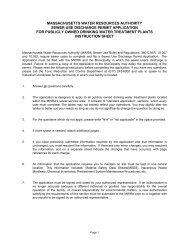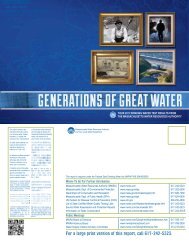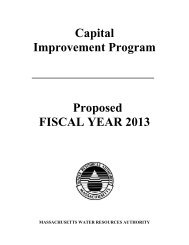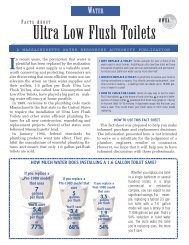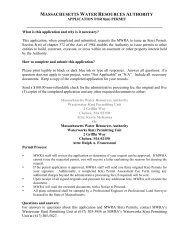Framingham - Massachusetts Water Resources Authority
Framingham - Massachusetts Water Resources Authority
Framingham - Massachusetts Water Resources Authority
Create successful ePaper yourself
Turn your PDF publications into a flip-book with our unique Google optimized e-Paper software.
Where Does Your <strong>Water</strong> Come From?Dear Customer,This report contains the 2010 test results on your drinking water.Hundreds of thousands of tests confirmed that the quality of yourwater is excellent. For 2010, MWRA met every federal and statedrinking water standard. System-wide, we have been below theLead Action Level for the past seven years. Please see yourcommunity’s letter for more information on your local system.Two upcoming projects will enhance the quality and safe deliveryof our water. Soon, we will begin building ultraviolet disinfectionfacilities at our Carroll <strong>Water</strong> Treatment Plant. Together withozone, this will give us two forms of powerful disinfection. Then, wewill be constructing a water tank and pumping station in Stonehamto provide storage for six communities, and redundancy for 21communities in case of an emergency.You may have heard press reports about a chemical called HexavalentChromium, or Chromium 6. Although there are no federalstandards for this substance, MWRA has begun voluntary testingfor it as recommended by the EPA. In response to the Japaneseearthquake, we have also tested for and found no traces of radioactiveiodine or cesium. As more information becomes available, wewill share it with you at www.mwra.com.Please take a moment to read the important information in thisreport. We want you to share our confidence in your drinking water.Sincerely,Frederick A. LaskeyExecutive DirectorMWRA Board Of DirectorsRichard K. Sullivan, Jr., Chairman, John J. Carroll, Vice-Chair,Joseph C. Foti, Secretary, Joel A. Barrera, Kevin L. Cotter,Michael S. Gove, James W. Hunt III, Vincent G. Mannering,Andrew M. Pappastergion, Marie T. Turner, John J. WalshYour <strong>Water</strong> Comes From the Quabbin Reservoir, about 65 miles west ofBoston, and the Wachusett Reservoir, about 35 miles west of Boston. These reservoirssupply wholesale water to local water departments in 51 communities. The two reservoirscombined supplied about 200 million gallons a day of high quality water to consumers in2010.The Quabbin and Wachusett watersheds are protected naturally with over 85% of thewatersheds covered in forest and wetlands. To ensure safety, the streams and reservoirs aretested often and patrolled daily by the Department of Conservation and Recreation (DCR).Rain and snow falling on watersheds – protected land around the reservoirs – turn intostreams that flow to the reservoirs. This water comes in contact with soil, rock, plants, andother material as it follows its natural path to the reservoirs.While this process helps to clean the water, it can also dissolve and carry very smallamounts of material into the reservoir. Minerals from soil and rock do not typically causeproblems in the water. But, water can also transport contaminants from human and animalactivity. These can include bacteria, viruses,and fertilizers – some of which can causeillness. The test data in this report show thatthese contaminants are not a problem in yourreservoirs’ watersheds.The Department of Environmental Protection(DEP) has prepared a Source <strong>Water</strong> AssessmentProgram report for the Quabbin andWachusett Reservoirs. The DEP reportcommends DCR and MWRA on the existingsource protection plans, and states that our“watershed protection programs are verysuccessful and greatly reduce the actual riskof contamination.” The report recommendsthat we maintain present watershed plansand continue to work with residents, farmers,and other interested parties to maintain thepristine watershed areas.The Green ChoiceAs water travels eastward directly to yourfaucet, clean hydro-energy is produced.MWRA also has wind turbines and solarpanels at our Deer Island Plant and solarpanels at our Carroll Treatment Plant.Tap water is delivered straight to yourhome without trucking or plastic waste.Drink tap water and be green!PHOTO BY ALLAN JUNG - THE METROWEST DAILY NEWSMWRA BOARD OF DIRECTORSRichard K. Sullivan, Jr., Chairman, John J. Carroll, Vice-Chair,Joseph C. Foti, Secretary, Joel A. Barrera, Kevin L. Cotter,QuabbinMichael S. Gove, James W. Hunt III, Vincent G. Mannering,WareReservoirRiverAndrew M. Pappastergion, Marie T. Turner, John J. WalshSpot Pond StorageTank (In Design)Nash HillStorageTankQuabbinAqueductQuabbinTreatmentPlantOakdaleHydroWachusettReservoirCosgroveHydroCarroll <strong>Water</strong>TreatmentPlant &Storage TankMetroWestTunnelHultmanAqueductLoring Rd.HydroLoring Rd.Storage TankNorumbegaStorageTankFellsStorageTankCity TunnelExtensionDorchesterTunnelBostonHarborBlue HillsStorage Tank1
From the Reservoir to Your Home<strong>Water</strong> Treatment The water you drink is treated at the John J. Carroll <strong>Water</strong> Treatment Plant in Marlborough.The first treatment step is disinfection of reservoir water. MWRA’s licensed treatment operators carefullyadd measured doses of ozone gas bubbles, produced from pure oxygen gas, to the water to kill any pathogens(germs) that may be present in the water. Fluoride is then added to reduce cavities. Next, thewater chemistry is adjusted to reduce corrosion of lead and copper from home plumbing. Last,we add mono-chloramine, a mild and long-lasting disinfectant combining chlorine andammonia, which protects the water while it is in the local pipelines.MWRA’s Improvements To The <strong>Water</strong> Supply 2010 marked the 25th anniversaryof the MWRA. In that time, MWRA and our community partners have made improvementsto the entire water system: from the watersheds, to the aqueducts and tunnels, totreatment plants, and to MWRA and local pipelines. These are the largest investments in thewater system since the 1930s. MWRA and our community partners continue to make thenecessary investments to maintain and upgrade our facilities. Take a look at our 25thanniversary report at www.mwra.com.Testing Your <strong>Water</strong> – Every Step Of The Way Test results show few contaminants are found inthe reservoir water. The few that are found are in very small amounts, well below EPA's standards. Turbidity(or cloudiness of the water) is one measure of overall water quality. There are two standards for turbidity: allwater must be below 5 NTU (Nephelometric Turbidity Units), and can only be above 1 NTU if it does notinterfere with effective disinfection. MWRA met both of these standards. Typical levels at the WachusettReservoir are 0.4 NTU and were below the 1 NTU over 99.99% of the time. The highest level was 1.69 NTU,but this did not interfere with effective disinfection. MWRA also tests reservoir water for pathogens such asfecal coliform, bacteria, viruses, and the parasites Cryptosporidum and Giardia. They can enter the water fromanimal or human waste. All test results were well within state and federal testing and treatment standards.Test Results – After Treatment EPA and State regulations require many water quality tests aftertreatment to check the water you are drinking. MWRA conducts tens of thousands of tests per year on over120 contaminants (for a complete list visit www.mwra.com). The only contaminants found are listed below, andall levels met EPA’s standards. The bottom line is that the water quality is excellent.CompoundBariumMono-chloramineFluorideNitrate^Nitrite^PerchlorateTotal TrihalomethanesHaloacetic Acids-5UnitsppmppmppmppmppmppbppbppbTest Results - After Treatment(MCL)HighestLevelAllowed24-MRDL410128060(We found)DetectedLevel-Average0.0091.81.050.140.010.061412.4Range ofDetections0.009-0.010-3.60.75-1.150.03-0.140.010.05-0.071.9-20.40-18(MCLG)IdealGoal24-MRDLGKEY: MCL=Maximum Contaminant Level. The highest level of a contaminant allowed in water. MCLs are set as close to theMCLGs as feasible using the best available technology. MCLG=Maximum Contaminant Level Goal - The level of contaminant indrinking water below which there is no known or expected risk to health. MCLGs allow for a margin of safety. MRDL=MaximumResidual Disinfectant Level. The highest level of a disinfectant allowed in drinking water. There is convincing evidence thataddition of a disinfectant is necessary for control of microbial contaminants. MRDLG=Maximum Residual Disinfectant LevelGoal. The level of a drinking water disinfectant below which there is no known or expected health risk. MRDLGs do not reflectthe benefits of the use of disinfectants to control microbial contamination. ppm=parts per million ppb=parts per billion ns=nostandard ^As required by DEP, the maximum result is reported for nitrate and nitrite, not the average.4101nsnsnsViolationNoNoNoNoNoNoNoNoHow it gets in the waterCommon mineral in nature<strong>Water</strong> disinfectantAdditive for dental healthAtmospheric depositionByproduct of water disinfectionByproduct of water disinfectionByproduct of water disinfectionByproduct of water disinfectionInformation AboutCross Connections<strong>Massachusetts</strong> DEP recommends the installationof backflow prevention devices for insideand outside hose connections to help protectthe water in your home as well as the drinkingwater system in your town. For more informationon cross connections, please call 617-242-5323or visit www.mwra.com/crosscon.html.Information onthe May 1st Boil<strong>Water</strong> OrderOn May 1st of 2010, a major pipe breakcaused a disruption in water service, and theactivation of a back-up water supply. MWRAhas several back-up supplies throughout theservice area for emergencies. This back-upsupply did not meet the high standards of ournormal reservoir, and therefore a precautionaryboil water order was needed. After repairsand many tests, normal water service wasback within 72 hours. If MWRA were to haveanother emergency, you would be notified viaradio, television, newspapers, state and localgovernment, health officials, and by MWRA.2
Tests in Community PipesMWRA And Local <strong>Water</strong> Departmentstest 300 to 500 water samples each week for totalcoliform bacteria. Total coliform bacteria can comefrom the intestines of warm-blooded animals, orcan be found in soil, plants, or other places. Mostof the time, they are not harmful. However, theirpresence could signal that harmful bacteria fromfecal waste may be there as well. The EPArequires that no more than 5% of the samples in amonth be positive. If a water sample does testpositive, we run more specific tests for E.coli,which is a bacteria found in human and animalfecal waste and may cause illness.MWRA has been working with EPA and otherresearchers to define new national drinkingwater standards by testing for unregulatedcontaminants. To better understand the drinkingwater, MWRA has voluntarily been testing forCryptosporidium and Giardia prior to treatment.No Cryptosporidium was detected in 2010.TestMeasurement UnitsAverageDrinking <strong>Water</strong> And People WithWeakened Immune Systems Somepeople may be more vulnerable to contaminantsin drinking water than the general population.Immuno-compromised persons such as personswith cancer undergoing chemotherapy, personswho have undergone organ transplants, peoplewith HIV/AIDS or other immune system disorders,some elderly, and infants can be particularly at riskfrom infections. These people should seek adviceabout drinking water from their health careproviders. EPA/CDC guidelines on appropriatemeans to lessen the risk of infection by Cryptosporidiumand other microbial contaminants areavailable from the EPA's Safe Drinking <strong>Water</strong>Hotline (1-800-426-4791).CommunityArlingtonBelmontBostonBrooklineChelsea<strong>Framingham</strong>SaugusSomervilleHighest % ofpositive samplesand month2.5% (May)4.3% (Aug)0.7% (May)1.1% (Aug)1.9% (Mar)2.6% (Nov)1.7% (May)7.0% (Nov)Violationof EPA’s5% limitNoNoNoNoNoNoNoYes*Giardia cysts per 100L 9.1MWRA’s disinfection is designed and operatedto kill Giardia.NDMAnanograms per liter0.54**The result is from 2009. The DEP guidancevalue for NDMA is 10 ng/L.Contaminants In Bottled <strong>Water</strong> AndTap <strong>Water</strong> Drinking water, including bottledwater, may reasonably be expected to contain atleast small amounts of some contaminants.Thepresence of contaminants does not necessarilyindicate that water poses a health risk. Moreinformation about contaminants and potentialhealth effects can be obtained by calling the EPA’sSafe Drinking <strong>Water</strong> Hotline (1-800-426-4791) orMWRA. In order to ensure that tap water is safe todrink, the <strong>Massachusetts</strong> DEP and EPA prescriberegulations which limit the amount of certaincontaminants in water provided by public watersystems. Food and Drug Administration (FDA)and <strong>Massachusetts</strong> Department of Public Healthregulations establish limits for contaminants inbottled water which must provide the sameprotection for public health.StonehamMWRA3.1% (Oct)0.8% (Aug)NoNoTap <strong>Water</strong>-The Smart Choice!How Did We Do In 2010?The table reports test results from 30communities that receive all of their water fromMWRA. No E.coli was found in any MWRAcommunity in 2010. *Residents of Somervilleshould read their community letter for moreinformation.Although tap water and bottledwater have to meet thesame standards,tap water mustmeet the moreintensive EPA testingrequirements. Yet, tapwater costs less than apenny per gallondelivered straight toyour home, whilebottled water costs from$1 to $8 a gallon.Facts AboutSodiumSodium in water contributes only a smallfraction of a person’s overall sodium intake(less than 10%). MWRA tests for sodiummonthly and the highest level found was 35.3mg/l (about 9 mg per 8 oz. glass). This wouldbe considered very low sodium by the Foodand Drug Administration.3
TOWN OF FRAMINGHAMDEPARTMENT OF PUBLIC WORKSF R A M I N G H A M , M A S S A C H U S E T T S 0 1 7 0 2Public <strong>Water</strong> Supply# 3100000PETER A. SELLERSEXECUTIVE DIRECTOR | FDPWPAUL G. BARDENDEPUTY DIRECTOR | FDPWWILLIAM R. SEDEWITZ - PECHIEF ENGINEER | FDPW“Dedicated toExcellencein PublicService”Dear Resident:<strong>Resources</strong> <strong>Authority</strong> (MWRA), this report was compiled to provide you with information about the water that we provide to you.The Town of <strong>Framingham</strong> operates one of the largest water systems within the MWRA service area as well as in the state. <strong>Water</strong> receivedfrom the MWRA is treated and disinfected at their new state-of-the-art water treatment plant. The Department of Public Works is responcommercialaccounts within the Community. The average daily water demand of nearly 7 million gallons per day (mgd) is purchased fromthe MWRA and is subsequently distributed throughout the Town via a complex distribution system that includes: 250 miles of pipe, 2000hydrants, 4800 gate valves, 20,000 meters, four pumping stations, two booster stations, and six above ground water tanks having a storagecapacity of nearly nine million gallons.for their lead content. The Environmental Protection Agency (EPA) has set the action level for lead in drinking water at 15 parts per billion(ppb). The results of our 2010 sampling program have successfully met that goal. The 90th percentile for lead was 4.1ppb during the March2010 round of sampling and 6.07 ppb for the September sampling event. Please see page 5 for more information on lead in tap water.The <strong>Framingham</strong> <strong>Water</strong> Department also performs approximately 900 bacteriological tests annually to ensure the quality and protectionof your drinking water. The Town maintained continuous compliance throughout the year with the Environmental Protection Agency’s standardsrelated to bacteria testing (Total Coliform Rule) but did experience atypical results. You will see within the report that <strong>Framingham</strong>is listed as testing positive for total coliform on 2.6% of the samples taken during November. Coliform is a group of bacteria most of whichis harmless however their presence in tap water is an indicator that harmful bacteria might be present. Immediate follow-up testing at theof Environmental Protection and the MWRA when unusual test results are received.The Department of Public Works is engaged in a multi-year program of long overdue infrastructure improvements which include numerouswater system projects. These improvements include the replacement of old pumping stations, rehabilitation of water storage tanks, installationof water system security measures, and the replacement of water pipes, some of which are more than 100 years old. These projectsPlease visit the Town’s website www.framinghamma.gov for additional information on your water system. You can also view an upcomingschedule of meetings and agendas which may include discussions related to the water system and which may be of interest to you.Please feel free to contact the <strong>Water</strong> Department at 508-532-6050 should you have any questions.Respectfully,Paul Barden | Deputy Director – FDPW
What YouNeed toKnow AboutLead InTap <strong>Water</strong>MWRA <strong>Water</strong> Is Lead-Free when itleaves the reservoirs. MWRA and local pipes thatcarry the water to your community are made mostlyof iron and steel and do not add lead to the water.However, lead can get into tap water through pipesin your home, your lead service line, lead solderused in plumbing, and some brass fixtures.Corrosion or wearing away of lead-based materialscan add lead to tap water, especially if water sits fora long time in the pipes before it is used.In 1996, MWRA began adding sodium carbonateand carbon dioxide to adjust the water's pH andbuffering capacity. This change has made thewater less corrosive, thereby reducing theleaching of lead into drinking water. Lead levels found in sample tests of tap water have dropped by almost 90percent since this treatment change.MWRA Meets Lead Standards In 2010 Under EPA rules, each year MWRA and your localwater department must test tap water in a sample of homes that are likely to have high lead levels. These areusually homes with lead service lines or lead solder. The EPA rule requires that 9 out of 10, or 90%, of thesampled homes must have lead levels below the Action Level of 15 parts per billion (ppb).All 14 sampling rounds over the past seven years have been below the EPA standard. Results for the 450samples taken in September 2010 are shown in the table. 9 out of 10 houses were below 7.03 ppb, which isbelow the Action Level of 15 ppb. Some individual communities had more than one home test above the ActionLevel for lead. If you live in one of these communities, your town letter will provide you with more information.LeadCopper0.07-57.50.003-0.3151.3KEY: AL= Action Level - The concentration of a contaminant which, if exceeded, triggers treatment orother requirements which a water system must follow. Definition of MCLG available on page 4.70605040302010060RangeSeptember 2010 Lead & Copper Results90% Value70.1(Target) ActionLevel(Ideal Goal)MCLG90% Lead Levels in MWRA Fully Served Communities1992 - 2010404416 1719Lead Level Action Level = 15 ppb110017 14 14 13# Homes Above AL/# Homes Tested8 810/4500/4501992 1997 1998 1999 2000 2001 2002 2003 2004 2005 2006 2007 2008 2009 2010117WhatCan I DoImportant LeadInformationfrom EPAIf present, elevated levels of lead can causeserious health problems, especially for pregnantwomen and young children. Lead in drinkingwater is primarily from materials and componentsassociated with service lines and homeplumbing. MWRA is responsible for providinghigh quality drinking water, but cannot controlthe variety of materials used in plumbing components.If your water has been sitting for severalhours, you can minimize the potential for leadexposure by flushing your tap for 30 seconds to2 minutes before using water for drinking orcooking. If you are concerned about lead in yourwater, you may wish to have your water tested.Information on lead in drinking water, testingmethods, and steps you can take to minimizeexposure is available from the Safe Drinking<strong>Water</strong> Hotline at 1-800-426-4791or at www.epa.gov/safewater/lead.to reduce exposureto lead in drinking water?Run the tap until after the water feels cold.To save water, fill a pitcher with fresh waterand place in the refrigerator for future use.Never use hot water from the faucet fordrinking or cooking, especially when makingbaby formula or other food for infants.Ask your local water department if there isa lead service line leading to your home.Check your plumbing fixtures to see ifthey are lead-free. Read the labels closely.Test your tap water. Call the MWRADrinking <strong>Water</strong> Hotline (617-242-5323) orvisit our website for more tips and a list ofDEP certified labs that can test your water.Be careful of places where you may findlead in or near your home. Paint, soil,dust and some pottery may contain lead.Call the MA Department of Public Healthat 1-800-532-9571 or EPA at1-800-424-LEAD for health information.5





